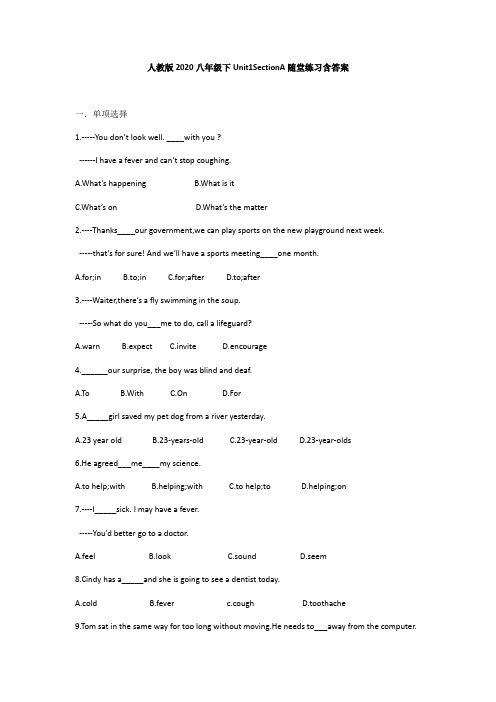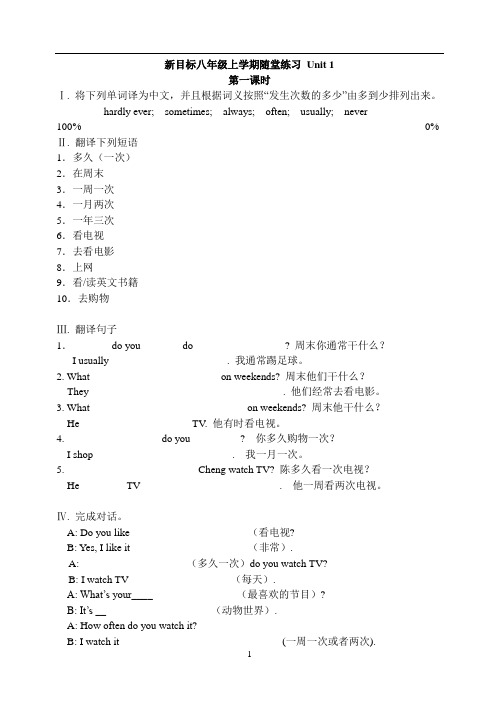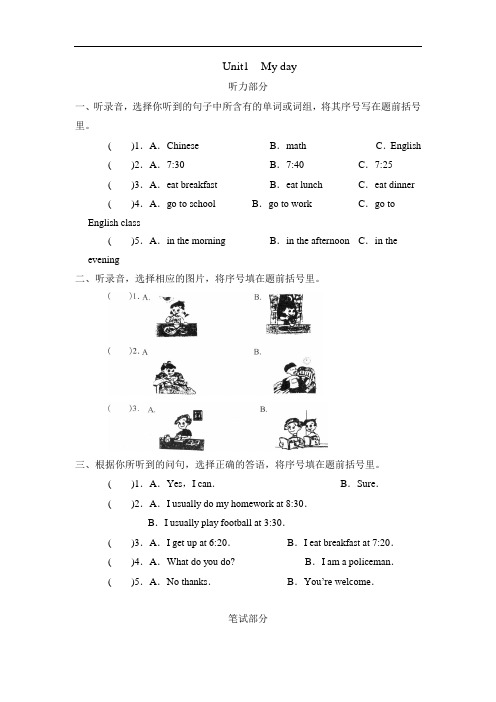12-1随堂1
- 格式:doc
- 大小:71.50 KB
- 文档页数:3

人教版2020八年级下Unit1SectionA随堂练习含答案一.单项选择1.-----You don’t look well. ____with you ?------I have a fever and can’t stop coughing.A.What’s happeningB.What is itC.What’s onD.What’s the matter2.----Thanks____our government,we can play sports on the new playground next week.-----that’s for sure! And we’ll have a sports meeting____one month.A.for;inB.to;inC.for;afterD.to;after3.----Waiter,there’s a fly swimming in the soup.-----So what do you___me to do, call a lifeguard?A.warnB.expectC.inviteD.encourage4.______our surprise, the boy was blind and deaf.A.ToB.WithC.OnD.For5.A_____girl saved my pet dog from a river yesterday.A.23 year oldB.23-years-oldC.23-year-oldD.23-year-olds6.He agreed___me____my science.A.to help;withB.helping;withC.to help;toD.helping;on7.----I_____sick. I may have a fever.-----You’d better go to a doctor.A.feelB.lookC.soundD.seem8.Cindy has a_____and she is going to see a dentist today.A.coldB.fever c.cough D.toothache9.Tom sat in the same way for too long without moving.He needs to___away from the computer.A.drink some hot tea with honeyB.get an X-rayB.take breaks D.see a dentist10.----I have a sore back.-----You should _______down and rest.A.to lieB.lyingC.lieD.lied11.what’s the matter ______your mother?A.withB.forC.inD.on12.I am tired after the long walk. I want to have a ______.A.talkB.lookC.partyD.rest13.That______like a good idea.A.feelsB.smellsC.soundsD.tastes14.Alice is old enough to look after______.A.sheB.herC.hersD.herself15.----My head feels very hot.----Maybe you have a __________.A.coldB.feverC.coughD.headache16._____,he is not honest.A.SurprisingB.In surpriseC.To my surpriseD.surprisedly17.Mark agreed_______me with my math.A.helpB.helpsC.helpingD.to help18.we have_______rain in our hometown this year.A.too muchB.much tooC.too manyD.many too19.A ______ girl named Wang Ping looked after disabled father.A.three-year-oldB.three-years-oldC.three years oldD.three year old20.-----_____the doctor, the most beautiful teacher Zhang Lili is out of danger.------We wish her to live healthy and happy life in the future.A.Tn front ofB.Thanks toC.As forD.Across from 二.根据句意完成句子21.他昨天说话太多并且没有喝足够的水。

新目标八年级上学期随堂练习Unit 1第一课时Ⅰ. 将下列单词译为中文,并且根据词义按照“发生次数的多少”由多到少排列出来。
hardly ever; sometimes; always; often; usually; never100%__________ _________ _________ _________ _________ _________ 0% Ⅱ. 翻译下列短语1.多久(一次)________________________________2.在周末________________________________3.一周一次________________________________4.一月两次________________________________5.一年三次________________________________6.看电视________________________________7.去看电影________________________________8.上网________________________________9.看/读英文书籍________________________________10.去购物_________________________________Ⅲ. 翻译句子1._______ do you _______ do ________ _______? 周末你通常干什么?I usually _________ ___________. 我通常踢足球。
2. What _______ _______ ______ on weekends? 周末他们干什么?They_____ ______ ______ ______ ______. 他们经常去看电影。
3. What _________ ________ ________ on weekends? 周末他干什么?He__________ _________ TV. 他有时看电视。

Unit1 My day听力部分一、听录音,选择你听到的句子中所含有的单词或词组,将其序号写在题前括号里。
( )1.A.Chinese B.math C.English ( )2.A.7:30 B.7:40 C.7:25( )3.A.eat breakfast B.eat lunch C.eat dinner( )4.A.go to school B.go to work C.go to English class( )5.A.in the morning B.in the afternoon C.in the evening二、听录音,选择相应的图片,将序号填在题前括号里。
三、根据你所听到的问句,选择正确的答语,将序号填在题前括号里。
( )1.A.Yes,I can.B.Sure.( )2.A.I usually do my homework at 8:30.B.I usually play football at 3:30.( )3.A.I get up at 6:20.B.I eat breakfast at 7:20.( )4.A.What do you do? B.I am a policeman.( )5.A.No thanks.B.You’re welcome.笔试部分一、根据句意和已给出的首字母,完成单词。
1.I usually do m exercises at 8:30.2.I usually play s at 3:30.3.W do you get up?4.I eat d at 7:00.二、选择题,将正确答案的序号写在题前括号里。
()1.Excuse me,can I ________ you some questions?A.ask B.asks C.tell()2.I usually ________ TV at 7:30 p.m.A.watches B.watch C.watching ()3.—What ________ you do?—I am a doctor.A.can B.are C.do ()4.—When do you go to school?—I go to school ________ 8:00 ________ the morning.A.at,at B.in,at C.at,in ()5.Thank you for ________ me about your day.A.telling B.tell C.ask()6.— ________do you go to work?—I go to work at 7:45 in the evening.A.What B.When C.Where三、根据中文提示,选择相应的英文句子,将序号写在题前括号里。

第十二单元化学与生活课题1 人类重要的营养物质本课题简单介绍了蛋白质、糖类、油脂、维生素对人体的营养作用,目的是让学生初步了解这几类物质在人的生命活动中的重要意义,了解正常安排饮食和从体外摄取必需的营养物质对人的生长发育等生命需求是至关重要的。
本课题的教学重点放在了拓宽视野上,并通过吸烟的危害,霉变的食物不能食用等资料来教育学生远离有害物质,且在整个课题中贯穿了合理摄取营养物质的教育。
【教学目标】1.知识与技能(1)了解营养素是指蛋白质、糖类、油脂、维生素、无机盐和水等六种物质。
(2)了解蛋白质、糖类、油脂、维生素与人体健康的关系。
2.过程与方法(1)通过阅读资料、上网查阅相关资料,了解和摄取相关的信息。
(2)从所学知识中意识到各种营养物质对人的生命活动的重要意义及合理安排饮食的重要性。
3.情感态度与价值观(1)意识到化学与生活有着密切的关系,在此基础上发展学习化学的兴趣。
(2)使学生更加热爱生命,能养成良好的生活习惯,以促使自己健康地成长。
【教学重点】1.蛋白质在人体中的主要作用。
2.学生视野的拓宽。
【教学难点】1.了解营养物质在人的生命活动中的作用及营养价值。
2.了解合理安排饮食的重要性。
【教具准备】多媒体课件等。
【导入新课】同学们,请回忆一下你们早上吃的是什么?学生讨论、交流。
【提出问题】我们知道,人类要维持生命,必须摄取食物。
那么,人类生存所需食物中营养素有哪些呢?这些营养素各起什么样的作用?【课件展示】教材 P90图12-1、P93图12-6、P94图12-7【归纳总结】人体生命的生存和健康离不开蛋白质、糖类、油脂、维生素、无机盐和水等六大类物质,通常称之为人体营养素。
【提出问题】这些营养素对人体生命活动各有哪些重要意义呢?【指导阅读】分四大组,分别指定阅读教材上关于蛋白质、糖类、油脂、维生素的内容介绍,结合教师课前布置查阅的有关资料,组内合作,讨论限时完成下面的任务:以第一人称手法写一份自我介绍的文段,题目自拟。


2021春国开电大一体化《管理心理学》随堂测试1-18参考答案管理心理学(50249)随堂测试1-18参考答案随堂测试1一、单选题(共1题,共20分)1、管理心理学的研究历史可以追溯到20世纪20年代的()。
参考答案是:D: 美国二、判断题(共4题,共80分)1、管理心理学作为一门应用理论科学,除了要解决迫切的实际任务外,当前还迫切需要完善自己的理论体系和方法论基础。
参考答案是:A:对2、管理心理学在西方称为“组织心理学”或“工业与组织心理学”。
参考答案是:A:对3、现在管理心理学是心理学的一个分支。
参考答案是:A:对4、管理心理学的名称在20世纪50年代出现于英国。
参考答案是:B:错随堂测试2一、判断题(共4题,共80分)1、组织用经济性奖酬来获取职工们的劳务与服从,是依据经济人假设而制定的管理策略。
参考答案是:A:对2、管理者的作用,只是要抓计划、组织与控制。
参考答案是:B:错3、社会人假设是指人的最大动机是社会需求,只有满足人的社会需求,才能对人有最大的激励作用。
参考答案是:A:对4、经济人又被称为“唯利人”,认为人的行为动机源于经济诱因,在于追求自身的最大利益。
参考答案是:A:对二、多选题(共1题,共20分)1、管理心理学家雪恩对人性的假设提出了一种分类,即存在着()。
A:经济人B:社会人C:自我实现人D:复杂人参考答案是:A B C D随堂测试3一、多选题(共1题,共20分)1、根据自我实现人假设,采取的管理策略需要从哪些方面改变()。
A:管理重点的改变B:管理职能的改变C:奖励方式的改变D:管理方式的改变参考答案是:A B C D二、判断题(共4题,共80分)1、复杂人假设是指人是很复杂的,但是们的需要与潜在的欲望是单一的。
参考答案是:B:错2、人本管理的终极目标是对人的人性化管理与个性化管理。
参考答案是:A:对3、尊重“人本性”是指要认同人的共性与个性,既要关心人的普遍共性,又要关注人的个性特征及特殊的利益诉求。
一be 动词的一般疑问句及肯否回答1.This is my handbag. Is this your handbag?Yes,it is. No, it isn’t.2.That is his pencil. Is that his pencil? Yes, it is. No,it isn’t.3.They are my students. Are they your students? Yes, they are. No, they aren’t.4.I am a teacher. Are you a teacher? Yes, I am. No,I’m not.二指示代词this/ that 的肯否回答1.This is my handbag. Is this your handbag?Yes, it is. No, it isn’t.2.That is his pencil. Is that his pencil? Yes, it is. No, it isn’t.3.This is my uncle. Is this your uncle? Yes, he is. No, he isn’t.4.That is my aunt. Is that your aunt?Yes, she is. No, she isn’t.三Excuse me & Sorry四Thank you very much.= Thanks very much.= Thanks a lot.LESSON3&4一be 动词的否定句(be 动词后+ not )5.This is my handbag. This is not my handbag. This isn’t my handbag.6.That is his pencil. That is not his pencil. That isn’t his pencil.7.They are my students. They are not my students. They aren’t my students.8.I am a teacher. I am not a teacher. I ’m not a teacher.二指示代词this/ that 的复数形式these/ thoseThese are my books. Are these your books? Yes, they are. No, they aren’t. Those are my suits. Are those your suits?Yes, they are. No, they aren’t. 三Here’s my ticket.Here’s the bus.公车来了Here’s the coat. 衣服给你一国籍划线提问(划线提问= 特殊疑问句方法:特殊疑问词+ 一般疑问句语序)1.She is French. What nationality is she?2.He is German. What nationality is he?3.Chang-woo is Korean. What nationality is Chang-woo?二品牌划线提问(划线提问= 特殊疑问句方法:特殊疑问词+ 一般疑问句语序)1.It’s a V olvo. What make is it?2.This is a Mecedes. What make is this?3.That car is a Ford. What make is that car?三国家、国籍、复数国籍总称(谓语用复数)单数复数国家中国人the Chinese a Chinese two ChineseChina日本人the Japanese a Japanese two JapaneseJapan瑞士人the Swiss a Swiss two Swiss Switzerland英国人the English an Englishman two Englishmen England法国人the French a Frenchman two Frenchmen France澳大利亚人the Australians an Australian two Australians Australia俄国人the Russians a Russian two RussiansRussia意大利人the Italians an Italian two ItaliansItalia希腊人the Greek a Greek two GreeksGreece美国人the Americans an American two Americans America印度人the Indians an Indian two IndiansIndia加拿大人the Canadians a Canadian two Canadians Canada德国人the Germans a German two Germans Germany瑞典人the Swedish a Swede two Swedes Sweden记忆口诀:中日瑞不变、英法都要变、其他国人加sLESSON7&8一工作/ 职业划线提问(划线提问= 特殊疑问句方法:特殊疑问词+ 一般疑问句语序)1.I’m a keyboard operator. What’s your job?2.He is an engineer. What’s his job?3.Xiaomei is a nurse. What’s Xiaomei’s job?4.They are taxi drivers. What are their jobs?5.They are postmen. What are their jobs?二Nice to meet you. = Nice to see you. = Glad to meet you .= Glad to see you. LESSON9&10一身体状况划线提问(划线提问= 特殊疑问句方法:特殊疑问词+ 一般疑问句语序)1.I am very well.How are you?2.He is fine today.How is he today?3.They are ill now.How are they now?二look at that manLook after the baby= take care of the babyLook up the dictionaryLesson11&12一名词所有格有些名词后加’s 表示其所有关系,这种形式就叫做名词所有格(a teacher’s book )1.有生命的名词1)一般名词后直接加s (children’s room / Tom’s cap / women’s dressses )2)复数名词并以s结尾的只加’(students’bags / the teachers’ room )3)表示并列共同拥有,最后一个名词加’sThis is Tom and Mike’s room. ( 这是汤姆和麦克共有的房间)4)表示各自有,各自后加’sThese areTom’s and Mike’s room.( 这是汤姆和麦克各自的房间)2无生命的名词:用名词+of 的结构表示所有关系The legs of table/ the picture of family二就名词所有格&物主代词划线提问(划线提问= 特殊疑问句方法:特殊疑问词+ 一般疑问句语序)This is Tim’s shirt. Whose shirt is this?Tim’s shirt is white. Whose shirt is white?The car is Paul’s. Whose is the car?The umbrella is Steven’s. Whose is the umbrella?This is their classroom. Whose classroom is this?三物主代词中文意思名词格主格(主人)(模范带头作用)一般放在句首宾格(宾客)一般放在句中句尾形容词性物主代词(老形家人胆子小)后接名词保镖名词词性物主代词(老名家人胆子大)没有名词保镖我I me my mine你you you your yours 他he him his his她she her her hrs它it it its its我们we us our ours 你们you you your yours 他们they them their theirs I love you.The boy likes her evry much.This is my book.This book is mine.四Here you are.LESSON13&14一颜色划线提问(划线提问= 特殊疑问句方法:特殊疑问词+ 一般疑问句语序)My new dress is green.What colour is your new dress?My coat is grey.What colour is your coat?二come upstairsHere it isThe same colourLesson15&16一名词变复数1.一般直接在名词词尾加s (friends / cats / chairs )2.以s、x、sh 、ch 结尾的名词加es (buses / boxes / brushes / watches)3.以辅音字母+y 结尾的名词,把y变i 加es (candies / stories / babies / cities )4.以f、fe结尾的名词,把f、fe变成vesleaf half self wife knife calfshelf wolf thief life树叶半数自己黄妻子拿刀去杀牛架后窜出一只狼就像小偷逃命忙5.以o结尾且有生命的加es (Negroes、heroes、volcanoes、tomatoes、potatoes)黑人英雄坐在火山上吃西红柿土豆二复习国籍划线提问(划线提问= 特殊疑问句方法:特殊疑问词+ 一般疑问句语序)1.She is French. What nationality is she?2.He is German. What nationality is he?3.Chang-woo is Korean. What nationality is Chang-woo?Lesson17&18一名词变复数不规则1.单复同形Chinese、Japanese、police、deer、sheep、fish、cattle中日警察友人来聚会鹿羊鱼牛齐齐把家回二变元音部分Man-men woman-women goose-geese child-children mouse-mice louse-lice ox-oxen三what are their jobs?= what do they do?What is your job?= what do you do? What are your jobs?= what do you do?What is his job? = what does he do? What is her job?= waht does she do?四how do you do?office assistantLesson19&20一They are......二What’s the matter?= What’s wrong?=Waht’s up?=Is there anything wrong with you?sit downall rightHere you arelook at that man 看那个男人look out 当心look over the paper检查试卷Lesson21&22一give sb. sth = give sth to sb.Give me a book = give a book to meGive him a cup = give a cup to himGive her the bottle = give the bottle to herGive us the tin = give the tin to usGive them the box = give the box to thema box of books一箱子书 a glass of water 一杯水 a cup of tea 一杯茶a bottle of water一瓶水 a tin of meat 一罐肉 a knife and fork一副刀叉a spoon of soup 一勺汤二which one?Which book?Which cup?Lessson23&24一give sb. sth = give sth to sb.Give me some glasses= give some glasses to meGive him some magazines = give some magazines to himGive her some spoons= give some spoons to herGive us somenewspapers = give some newspapers to usGive them some cigaettes= give some cigaettes to them二on the shelfWhich glasses?Which ties?Which plates?Which ones?Lesson25&26一there be 句型1.there is a+单数名词+地点状语There is a refrigerator in the kitchen.There is an electric cooker in the kitchen.There is a table in the middle of the room.2.there are some +复数名词+地点状语There are some magazines on the television. There are some newspapers on the tables.There are armchairs in the room.3.there be+就近原则+地点状语There is a book and three magazines on the desk. There are three magazines and a book on the desk.4.there be+doing+地点状语There is a boy reading under the tree.There are some girls singing in the room.There is some water in the bottle. Is there any water in the bottle?There are some books on the desk. Are there any books on the desk?There are some magazines on the television. Are there any magazines on the television?二in the kitchenon the rightan electric cookeron the lefton the rightin the middle ofon the tablewhere is it?Lesson27&28一there be 句型6.There is a+单数名词+地点状语There is a refrigerator in the kitchen.There is an electric cooker in the kitchen.7.There are some +复数名词+地点状语There are some magazines on the television.There are some newspapers on the tables.8.There be+就近原则+地点状语There is a book and three magazines on the desk.There are three magazines and a book on the desk.9.There be+doing+地点状语There is a boy reading under the tree.There is some water in the bottle. Is there any water in the bottle?There are some books on the desk. Are there any books on the desk?There are some magazines on the television. Are there any magazines on the television?二in the roomnear the windowon the televisionon the tablenear the tablenear the dooron the stereoon the wallA pair of trousersLesson 29&30一祈使句省略主语,表示直接的命令、建议、告诫、邀请等多种意图的句子叫做祈使句。
Unit1 随堂检测一、单项选择。
( )1.—Your scarf is so beautiful! Who bought it for you? —Oh, my daughter made it by ________. A.myself B.herself C.himself( )2.His story is ____________ to make us all happy. A.enough boring B.boring enough C.funny enough D.enough funny( )3.—How do you like the movie? —I think it’s great, but my brother feels it very________. A.bored B.boring C.relaxed D.relaxing( )4.─I'm __________, Mom. Can I have something to eat?─OK. Here are some cakes. A.thin B.heavy C.hungry D.tired( )5.I saw ________ at the shopping center, so I went back home early. A.something interesting B.nothing interesting C.interesting something D.interesting nothing( )6.Mrs. Brown forgot ______ the door and two bad men got in. A.locking B.to lock C.locked D.lock( )7.I didn't get to school on time this morning the heavy rain. A.because B.because of C.so D.in( )8.一What did your sister do last summer ? 一She_______my aunt and stayed there for two weeks . A.visit B.visited C.visits D.will visit ( )9.—Jim, you play the guitar very well. Who taught you? —No one, I just taught _________. A.yourself B.himself C.herself D.myself( )10.—Who taught ________ English last year, Michael? —I learned it by________. A.you; myself B.your; myself C.yourself; me D.yourself; myself ( )11.We ________ Beijing at 10 p.m. yesterday. A.arrive at B.arrived in C.arrived at D.arrive in( )12.On our way back home yesterday, we ________ to have lunch in a restaurant. A.stopped B.stop C.will stop D.would stop( )13.Mum, my shirt is too old. Could you buy a new one ________ me? A.for B.to C.with D.of( )14.─Oh. my God! I forgot to bring my pen here. ─Don't worry. I have two. You can use __________. A.I B.me C.myself D.mine( )15.From the top of the hill we can see the whole city ______ us. A.under B.below C.over D.above二、单词填空。
7⽉12⽇第⼀章⼏何构造分析随堂练习第1章⼏何构造分析3⼤规则最常⽤的基本刚⽚有以下四种:单链杆、铰结三⾓形、刚结点构件、⼤地刚⽚。
三刚⽚规则三个刚⽚⽤不在同⼀直线上的三个单铰两两铰结,组成的体系是⼏何不变的。
【练习题1-1】试对图⽰平⾯体系进⾏⼏何组成分析。
a.(东南⼤学2011)b.(天津⼤学2016)c.(哈尔滨⼯业⼤学2015)d.(哈尔滨⼯业⼤学2015)提⽰:从前述最常⽤的四种基本刚⽚(单链杆、铰结三⾓形、刚结点构件、⼤地刚⽚)找到规则所需的三个刚⽚,尤其是隐蔽的⼤地刚⽚。
两刚⽚规则两个刚⽚⽤⼀个铰和⼀根不通过此铰的链杆相连,组成的体系是⼏何不变的;或者两个刚⽚⽤三根不全平⾏也不交于同⼀点的链杆相连,为⼏何不变体系。
【练习题1-2】试对图⽰平⾯体系进⾏⼏何组成分析。
⼆元体规则⼆元体:两个刚⽚与⼀个体系间只⽤三个不在⼀直线上的铰两两相连,则两个刚⽚称为⼆元体。
最简单常见的⼆元体是指由两根不在同⼀直线上的链杆连接⼀个新结点的装置。
⼆元体本质上还是在原⼏何体系上构造出⼀个新的铰结三⾓形,因此本质上就是铰结三⾓形。
在⼀个体系上增加或拆除⼆元体,不会改变原有体系的⼏何构造性质。
值得注意的是:构成⼆元体的两根链杆不⼀定是直杆,只要是刚⽚就⾏。
【练习题1-3】试对图⽰平⾯体系进⾏⼏何组成分析。
a.(中南⼤学2012)b.(东南2010)c.(东南2010)d.(北京⼯业⼤学2011)e.(东南⼤学2011)提⽰:找出⼆元体并依次去掉⼆元体,最后分析体系剩余部分的⼏何构造特性。
记住,⼆元体不⼀定得是直杆组成。
2⼤可变体系1. 瞬变与常变的区分瞬变体系与常变体系的两个判定规则:微⼩变形规则让体系发⽣微⼩变形,若三铰依然在同⼀直线上,则是常变体系,不在同⼀直线上,则是瞬变体系。
平⾏等长规则(特别注意平⾏等长的对象是谁)组成⽆穷远铰的两根平⾏链杆与另外两铰的连线等长且始终平⾏(即发⽣微⼩位移后依然平⾏),则为常变体系,否则为瞬变体系。
A. an chineseB. ChineseC. the ChineseD. one Chinese33. It's the same colour.22. That's a hat.(对划线部分提问)A. inB. atC. toD. onA. Thank A. orB. andC. butD. soA. eitherB. Too Ⅰ.单词拼写1. col (颜色)2. gr n (绿色的)3. n ce (美好的)13. A new dress14. What colour is your…?LESSON难度系数(1.0)B. Thank yourC. Thanks youD. Thank you A. Who's B. WhoseC. WhoD. Whom20. hat is it? —you're welcome— .A. aB. anC. theD. me— .A. comeB. ComeC. ComingD. Going 4. upst s (楼上) 5. sm t(时髦的、漂亮的)6. h t (帽子)7. s me (相同的)8. l vely (可爱的)Ⅱ.语法和词汇(从A、B、C、D中选出最佳选项)11. — is your coat? —Black.9. c s e(箱子) 9. c pet (地毯)21. My new dress is green .(对划线部分提问)16. Come upstairs see it.17. I am .14. That's lovely hat.15. What colour is your new hat?12. upstairs and see it.13. My hat is new .29. How is (you) mother.30. What colour is (your sister) new dress?C. too D. also A. What B. Where C. Whose D. What colour Ⅲ.句子练习(根据下列要求完成句子)A. 句型转换19. —Hello! Here is your pincil-box.18. Please look the picture on the wall.25. His umbrella is red.(改为否定句)B. 用所给词适当的形式填空.26. (who) shirt is this?27. Whose is this tie? It's . (Steven) tie.23. What colour is it?(用green回答)28. I have (a/an) passport.Ⅳ.翻译句子(英译汉、汉译英)31. What colou's your new dress?34. That is a lovely hat.32. Come upstairs and see it?24. My dog is white and brown .(对划线部分提问)A B ( ) 49. What make is the car?( ) 50. What's his job?( ) 51( ) 52( ) 53( ) 54 Anna 买了一条新连裙,是蓝色的。
第12章第1讲
1.如图12-1-9所示,一矩形线圈套在蹄形磁铁的一个磁极上,当线圈向下平移时,则()
图12-1-9
A.因ad边切割磁感线,线圈中有感应电流产生
B.因穿过线圈的磁通量始终为零,线圈中没有感应电流产生
C.因穿过线圈的磁通量增加,线圈中有感应电流产生
D.因穿过线圈的磁通量减少,线圈中有感应电流产生
答案:AC
2.带电圆环绕圆心旋转,在环的中心处有一闭合小线圈,小线圈和圆环在同一平面内,则()
A.只要圆环在转动,小线圈内就一定有感应电流
B.不管圆环怎样转动,小线圈内都没有感应电流
C.圆环做变速转动时,小线圈内一定有感应电流
D.圆环做匀速转动时,小线圈内没有感应电流
解析:选CD.带电圆环旋转时,与环形电流相当,若匀速旋转,电流恒定,周围磁场不变,穿过小线圈的磁通量不变,不产生感应电流;若变速转动,相当于电流变化,周围产生变化的磁场,穿过小线圈的磁通量变化,产生感应电流.综上所述,C、D项正确.3.如图12-1-10所示,MN是一根固定的通电长直导线,电流方向向上.今将一金属线框abcd放在导线上,让线框的位置偏向导线的左边,两者彼此绝缘,当导线中的电流I突然增大时,线框整体受力情况为()
图12-1-10
A.受力向右B.受力向左
C.受力向上D.受力为零
解析:选A.线框内左边部分磁感线穿出,右边部分磁感线穿入,由于线框位置偏向导线左边,所以整个线框的总磁通量是垂直纸面向外的,并且随电流的增大而增大.用“阻碍磁通量变化”来考虑线框受磁场力作用而运动的方向,显然,线框只有向右运动,因此线框所受的磁场力应向右.A项正确.
4.如图12-1-11所示,水平放置的两条光滑轨道上有可自由移动的金属棒PQ、MN,当PQ在外力作用下运动时,MN在磁场力的作用下向右运动,则PQ所做的运动可能是()
图12-1-11
A.向右加速运动B.向左加速运动
C.向右减速运动D.向左减速运动
解析:选BC.MN棒中有感应电流,受安培力作用而向右运动,由左手定则可判断出MN 中电流的方向是由M流至N,此电流在L1中产生磁场的方向是向上的.
若PQ棒向右运动,由右手定则及安培定则可知L2产生磁场的方向也是向上的.由于L1产生的磁场方向与L2产生磁场的方向相同,可知L2产生磁场的磁通量是减少的,故PQ棒做的是向右的匀减速运动,C选项是可能的.
若PQ棒向左运动,则它产生的感应电流在L2中产生的磁场是向下的,与L1产生的磁场方向是相反的,由楞次定律可知L2中的磁场是增强的,故PQ棒做的是向左的加速运动.B 选项是可能的.
5.电阻R、电容C与一线圈连成闭合回路,条形磁铁静止于线圈的正上方,N极朝下,如图12-1-12所示.现使磁铁开始自由下落,在N极接近线圈上端的过程中,流过R的电流方向和电容器极板的带电情况是()
图12-1-12
A.从a到b,上极板带正电
B.从a到b,下极板带正电
C.从b到a,上极板带正电
D.从b到a,下极板带正电
解析:选D.本题主要考查电磁感应现象及楞次定律.磁铁下落,穿过线圈的磁通量向下增加,根据楞次定律线圈中感应电流的磁场方向向上,再根据安培定则(右手螺旋定则)判断出线圈中感应电流的方向,此时线圈等效于一个电源,在电源内部电流从负极流向正极,所以线
圈下端为正极,上端为负极,从而判断流过R的电流方向为从b到a,电容器的下极板带正电.。